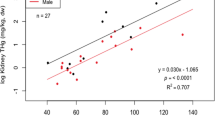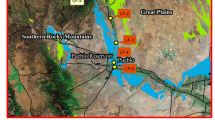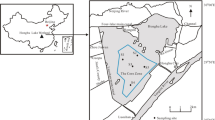Abstract
Samples of breast muscle from 32 species of waterfowl collected from 123 sites across Canada were analyzed for chlorobenzenes (CBz), chlordane-related compounds (CHL), hexachlorocyclohexanes (HCH), DDT, mirex, dieldrin, PCBs and mercury. ΣDDT, ΣCBz and ΣPCB were the compounds most frequently found above trace levels. ΣHCH and ΣMirex were detected the least often. Mercury was detected in all of the mergansers, over 50% of dabbling, bay and sea ducks, and in less than 2% of the geese analysed. The highest levels of contaminants were generally found in birds feeding at higher trophic levels such as sea ducks and mergansers. With the exception of a few samples of mergansers and long-tailed ducks from eastern Canada, which contained ΣPCB concentrations of 1.0–2.4 mg kg−1, ΣPCB levels were less than 1 mg kg−1 wet weight. Only one merganser from eastern Canada had a ΣDDT concentration (2.6 mg kg−1 ww) which was greater than 1 mg kg−1 ww. The highest ΣCHL (0.10 mg kg−1 ww) was also found in mergansers from eastern Canada. Levels of total mercury in breast muscle were either low (< 1 mg kg−1 ww) or below detection limits with the exception of a few samples of mergansers from eastern Canada which contained mercury concentrations of 1.0–1.5 mg kg−1 ww. Health Canada determined that the organochlorine and mercury levels found in samples of breast muscle of ducks and geese analysed in this study did not pose a health hazard to human consumers and therefore these waterfowl were safe to eat.
Similar content being viewed by others
References
Alton Mackey, M. G. and Moore Orr, R. D.: 1988, ‘The seasonal nutrient density of country food harvested in Makkovik, Labrador’, Arctic 41, 105–108.
Anderson, D. W. and Hickey, J. J.: 1976, ‘Dynamics of storage of organochlorine pollutants in herring gulls’, Environ. Pollut. 10, 183–200.
Annett, C. S., D'Itri, F. M., Ford, J. R. and Prince, H. H.: 1975, ‘Mercury in fish and waterfowl from Ball Lake, Ontario’, J. Environ. Qual. 4, 219–222.
Avrahami, M. and Steele, R. T.: 1972, ‘Hexachlorobenzene. II. Residues in laying pullets fed HCB in their diet and the effects on egg production, egg hatchability, and on chickens’, N.Z. J. Agric. Res. 15, 482–488. (Cited in Wiemeyer, 1996).
Baker, F. D., Tumasonis, C. F., Stone, W. B. and Bush, B.: 1976, ‘Levels of PCB and trace metals in waterfowl in New York State’, N.Y. Fish Game J. 23, 82–91.
Ballschmiter, K. and Zell, M.: 1980, ‘Analysis of polychlorinated biphenyls (PCBs) by glass capillary gas chromatography. Composition of technical Aroclor- and Clophen-PCB mixtures’, Fres. Z. Anal. Chem. 302, 20–31.
Bard, S. M.: 1999, ‘Global transport of anthropogenic contaminants and the consequences for the Arctic marine ecosystem’, Mar. Pollut. Bull. 38, 356–379.
Barr, J. F.: 1986, ‘Population Dynamics of the Common Loon (Gavia immer) Associated with Mercury Contaminated Waters in Northwestern Ontario’, Canadian Wildlife Service Occasional Paper, No. 56, 25 pp.
Barrie, L. A., Gregor, D., Hargrave, B., Lake, R., Muir, D., Shearer, R., Tracey, B. and Bidleman, T.: 1992, ‘Arctic contaminants: sources, occurrence and pathways’, Sci. Tot. Environ. 122, 1–74.
Baskett, T. S.: 1975, ‘Residues in fish, wildlife and estuaries’, Pestic. Monit. J. 9, 67–78.
Bellrose, F. C.: 1980, Ducks, Geese and Swans of North America, 3rd ed., Stackpole Books, Harrisburg, PA, 540 pp.
Blus, L. J., Henny, C. J., Stafford, C. J. and Grove, R. A.: 1987, ‘Persistence of DDT and metabolites in wildlife from Washington state orchards’, Arch. Environ. Contam. Toxicol. 16, 467–476.
Braune, B. M., Malone, B., Burgess, N. M., Elliott, J. E., Garrity, N., Hawkings, J., Hines, J., Marshall, H., Marshall, W. K., Rodrigue, J., Wakeford, B., Wayland, M., Weseloh, D. V. and Whitehead, P. E.: 1999, ‘Chemical Residues in Gamebirds Harvested in Canada, 1987–95’, Canadian Wildlife Service Technical Report Series, No. 326, Ottawa, 443 pp. Available at http://www.cws-scf.ec.gc.ca/publications/AbstractTemplate.cfm?lang=e&id=326
Braune, B. M., Wong, M. P., Belles-Isles, J.-C. and Marshall, W. K.: 1991, ‘Chemical Residues in Canadian Game Birds’, Canadian Wildlife Service Technical Report Series, No. 124, Ottawa, 375 pp.
Bredin, K. A., Burgess, N. M., McCorquodale, D. B. and Harris, D. L.: 1997, ‘Volunteer Surveys of Waterbirds of the Sydney, Nova Scotia Area, Including the Sydney Tar Ponds, 1993–1996’, Canadian Wildlife Service Technical Report Series, No. 273, Ottawa, 40 pp.
Cain, B. W.: 1988, ‘Wintering Waterfowl Habitat in Texas: Shrinking and Contaminated’, in: M.W. Weller (ed), Waterfowl in Winter, University of Minnesota Press, Minneapolis, pp. 583–596.
Cameron, M. and Weis, I. M.: 1993, ‘Organochlorine contaminants in the country food diet of the Belcher Island Inuit, Northwest Territories, Canada’, Arctic 46, 42–48.
Cohen, J. B., Barclay, J. S., Major, A. R. and Fisher, J. P.: 2000, ‘Wintering greater scaup as biomonitors of metal contamination in federal wildlife refuges in the Long Island Region’, Arch. Environ. Contam. Toxicol. 38, 83–92.
Custer, T. W., Sparks, D. W., Sobiech, S. A., Hines, R. K. and Melancon, M. J.: 1996, ‘Organochlorine accumulation by sentinel mallards at the Winston-Thomas sewage treatment plant, Bloomington, Indiana’, Arch. Environ. Contam. Toxicol. 30, 163–169.
Dahlgren, R. B., Bury, R. J., Linder, R. L. and Reidinger Jr., R.F.: 1972, ‘Residue levels and histopathology in pheasants given polychlorinated biphenyls’, J. Wildl. Manage. 36, 524–533.
Desai-Greenaway, P. and Price, I. M.: 1976. ‘Mercury in Canadian Fish and Wildlife Used in the Diets of Native People’, Canadian Wildlife Service Manuscript Report, No. 35, Ottawa, 61 pp.
Dickson, K. and Métras, L.: 1987, ‘Migratory Birds Killed in Canada During the 1986 Season’, Canadian Wildlife Service Progress Notes, No. 171, Ottawa, 42 pp.
Dietz, R., Riget, F. and Johansen, P.: 1996, ‘Lead, cadmium, mercury and selenium in Greenland marine animals’, Sci. Total Environ. 186, 67–93.
Dobos, R. Z., Painter, D. S. and Mudroch, A.: 1991, ‘Contaminants in wildlife utilizing confined disposal facilities’, Inter. J. Environ. Pollut. 1, 73–86.
Ehrlich, P. R., Dobkin, D. S. and Wheye, D.: 1988, The Birder's Handbook: A Field Guide to the Natural History of North American Birds, Simon & Schuster Inc., New York, 785 pp.
Elliott, J. E. and Martin, P. A.: 1998, ‘Chlorinated hydrocarbon contaminants in grebes and sea ducks wintering on the coast of British Columbia, Canada: 1988–1993’, Environ. Monit. Assess. 53, 337–362.
Elliott, J. E., Martin, P. A., Arnold, T. W. and Sinclair, P. H.: 1994, ‘Organochlorines and reproductive success of birds in orchard and non-orchard areas of central British Columbia, Canada 1990–91’, Arch. Environ. Contam. Toxicol. 26, 435–443.
Fimreite, N., Holsworth, W. N., Keith, J. A., Pearce, P. A. and Gruchy, I. M.: 1971, ‘Mercury in fish and fish-eating birds near sites of industrial contamination in Canada’, Can. Fld-Nat. 85, 211–220.
Fimreite, N.: 1974, ‘Mercury contamination of aquatic birds in northwestern Ontario’, J. Wildl. Manage. 38, 120–131.
Fletcher, M. R.: 1972, ‘Effects of hexachlorobenzene on Japanese quail’, Proc. West. Assoc. State Game Fish Comm. 52, 374–383. (Cited in Wiemeyer, 1996)
Foley, R. E.: 1992, ‘Organochlorine residues in New York waterfowl harvested by hunters in 1983–1984’, Environ. Monit. Assess. 21, 37–48.
Foley, R. E. and Batcheller, G. R.: 1988, ‘Organochlorine contaminants in common goldeneye wintering on the Niagara River’, J. Wildl. Manage. 52, 441–445.
Gamble, R. L.: 1987, ‘Native Harvest of Wildlife in Keewatin Region, Northwest Territories for the Period October 1985 to March 1986 and a Summary for the Entire Period of the Harvest Study from October 1981 to March 1986’, Canadian Data Report of Fisheries Aquatic Science, No. 688, Winnipeg, MB, 85 pp.
Gebauer, M. B. and Weseloh, D. V.: 1993, ‘Accumulation of organic contaminants in sentinel mallards utilizing confined disposal facilities at Hamilton Harbour, Lake Ontario, Canada’, Arch. Environ. Contam. Toxicol. 25, 234–243.
Haseltine, S. D., Finley, M. T. and Cromartie, E.: 1980, ‘Reproduction and residue accumulation in black ducks fed toxaphene’, Arch. Environ. Contam. Toxicol. 9, 461–471.
Heath, R. G.: 1969, ‘Nationwide survey of residues of organochlorine pesticides in wings of mallards and black ducks’, Pestic. Monit. J. 3, 115–123.
Hebert, C. E., Haffner, G. D., Weis, I. M., Lazar, R. and Montour, L.: 1990, ‘Organochlorine contaminants in duck populations of Walpole Island’, J. Great Lakes Res. 16, 21–26.
Hebert, C. E., Norstrom, R. J., Simon, M., Braune, B. M., Weseloh, D. V. and Macdonald, C. R.: 1994a, ‘Temporal trends and sources of PCDDs and PCDFs in the Great Lakes: Herring gull egg monitoring, 1981–1991’, Environ. Sci. Technol. 28, 1268–1277.
Hebert, C. E., Weseloh, D. V., Kot, L. and Glooschenko, V.: 1994b, ‘Organochlorine contaminants in a terrestrial foodweb on the Niagara Peninsula, Ontario, Canada’, Arch. Environ. Contam. Toxicol. 26, 356–366.
Hebert, C. E., Norstrom, R. J. and Weseloh, D. V.: 1999. ‘A quarter century of environmental surveillance: The Canadian Wildlife Service's Great Lakes Herring Gull Monitoring Program’, Environ. Rev. 7, 147–166.
Heinz, G. H.: 1979, ‘Methylmercury: Reproductive and behavioural effects on three generations of mallard ducks’, J. Wildl. Manage. 43, 394–401.
Heinz, G. H., Miller, D. S., Ebert, B. J. and Stromborg, K. L.: 1994, ‘Declines in organochlorines in eggs of red-breasted mergansers from Lake Michigan, 1977–1978 versus 1990’, Environ. Monit. Assess. 33, 175–182.
Holt, G., Froslie, A. and Norheim, G.: 1979, ‘Mercury, DDE, and PCB in the avifauna in Norway 1965–1976’, Acta Vet. Scand. Suppl. 70, 1–28.
Hyde, K. M., Graves, J. B., Watts, A. B. and Bonner, F. L.: 1973, ‘Reproductive success of mallard ducks fed mirex’, J. Wildl. Manage. 37, 479–484.
Jacknow, J., Ludke, J. L. and Coon, N. C.: 1986, ‘Monitoring Fish and Wildlife for Environmental Contaminants: the National Contaminant Biomonitoring Program’, Fish Wildlife Leaflet, No. 4, U.S. Fish Wildlife Service, Washington, D.C., 15 pp.
James Bay and Northern Québec Native Harvesting Research Committee: 1988, ‘Final Report: Research to Establish Present Levels of Native Harvesting for the Inuit of Northern Québec. 1976–1980’, Final Report, James Bay and Northern Québec Native Harvesting Research Committee, Québec.
Kim, H. T., Kim, K. S., Kim, J. S. and Stone, W. B.: 1985, ‘Levels of polychlorinated biphenyls (PCBs), DDE, and mirex in waterfowl collected in New York State, 1981–1982’, Arch. Environ. Contam. Toxicol. 14, 13–18.
Kim, K. S., Pastel, M. J., Kim, J. S. and Stone, W. B.: 1984, ‘Levels of polychlorinated biphenyls, DDE and mirex in waterfowl collected in New York State, 1979–1980’, Arch. Environ. Contam. Toxicol. 13, 373–381.
Kuhnlein, H. V.: 1991, ‘Dietary Evaluation of Food, Nutrients and Contaminants in Fort Good Hope and Colville Lake, Northwest Territories’, Final Report to Medical Services Branch and National Health Research and Development Program – North 60°, Health and Welfare Canada, McGill University, Montreal, 138 pp.
Legris, A. M. and Lévesque, H.: 1991, ‘Migratory Game Birds Harvested in Canada During the 1990 Hunting Season’, Canadian Wildlife Service Progress Notes, No. 197, 40 pp.
Lévesque, H., Collins, B. and Legris, A. M.: 1993, ‘Migratory Game Birds Harvested in Canada During the 1991 Hunting Season’, Canadian Wildlife Service Progress Notes, No. 204, 42 pp.
Mehrle, P. M., Finley, M. T., Ludke, J. L., Mayer, F. L. and Kaiser, T. E.: 1979, ‘Bone development in black ducks as affected by dietary toxaphene’, Pest. Biochem. Physiol. 10, 168–173.
Michigan DNR: 1993, ‘Michigan Wildlife Contaminant Monitoring Program’, 1992 Annual Report, Michigan Department of Natural Resources.
Mullie, A., Ross, R. K. and Dennis, D. G.: 1996, ‘Overview of Migrant Waterfowl Use of the Great Lakes Areas of Concern and Other Selected Coastal Sectors in Southern Ontario’, Canadian Wildlife Service Technical Report Series, No. 261, Ottawa, 144 pp.
Nebeker, A. V., Griffis, W. L., Stutzman, T. W., Schuytema, G. S., Carey, L. A. and Scherer, S. M.: 1992, ‘Effects of aqueous and dietary exposure of dieldrin on survival, growth and bioconcentration in mallard ducklings’, Environ. Toxicol. Chem. 11, 687–699.
Norstrom, R. J., Simon, M., Muir, D. C.G. and Schweinsburg, R. E.: 1988, ‘Organochlorine contaminants in arctic marine food chains: Identification, geographical distribution, and temporal trends in polar bears’, Environ. Sci. Technol. 22, 1063–1071.
Norstrom, R. J. and Won, H. T.: 1985, ‘Long-term preservation of egg and tissue homogenates for determination of organochlorine compounds: freezing versus freeze-drying’, J. Assoc. Off. Anal. Chem. 68, 130–135.
Ohlendorf, H. M. and Miller, M. R.: 1984, ‘Organochlorine contaminants in California waterfowl’, J. Wildl. Manage. 48, 867–877.
Peakall, D. B. and Peakall, M. L.: 1973, ‘Effects of a polychlorinated biphenyl on the reproduction of artificially and naturally incubated dove eggs’, J. Appl. Ecol. 10, 863–868.
Pearce, P. A., Price, I. M. and Reynolds, L. M.: 1976, ‘Mercury in waterfowl from eastern Canada’, J. Wildl. Manage. 40, 694–703.
Perkins, C. P. and Barclay, J. S.: 1997, ‘Accumulation and mobilization of organochlorine contaminants in wintering greater scaup’, J. Wildl. Manage. 61, 444–449.
Peterson, S. R. and Ellarson, R. S.: 1976, ‘Total mercury residues in livers and eggs of oldsquaws’, J. Wildl. Manage. 40, 704–709.
Platenow, N. S., Karstad, L. H. and Saschenbrecker, P. W.: 1973, ‘Tissue distribution of polychlorinated biphenyls (Aroclor 1254) in cockerels; relation to the duration of exposure and observations on pathology’, Can. J. Comp. Med. 37, 90–95.
Porter, P. S., Ward, R. C. and Bell, H. F.: 1988, ‘The detection limit’, Environ. Sci. Technol. 22, 856–861.
Prevett, J. P., Lumsden, H. G. and Johnson, F. C.: 1983, ‘Waterfowl kill by Cree hunters of the Hudson Bay Lowland, Ontario’, Arctic 36, 185–192.
Prouty, R. M. and Bunck, C. M.: 1986, ‘Organochlorine residues in adult mallard and black duck wings, 1981–82’, Environ. Monit. Assess. 6, 49–57.
Robbins, C. S., Bruun, B. and Zim, H. S.: 1983, Birds of North America, Golden Press, New York, 360 pp.
Rodrigue, J., Desgranges, J.-L. and Titman, R.: 1992, ‘Use of Peking Ducks (Anas platyrhynchus) as a Bioindicator of Contamination by Bioaccumulative Substances in the Natural Environment (St. Lawrence River, Canada)’, in: J. Bohac (ed), Proceedings of the VIth International Conference of Bioindicatores Deteriorisation Regionis, Institute of Landscape Ecology CAS, Ceske Budejovice, Czechoslovakia, pp. 278–285.
Schmitt, C. J. and Bunck, C. M.: 1995, ‘Persistent Environmental Contaminants in Fish and Wildlife’, in: E. T. Laroe, G. S. Farris, C. E. Puckett, P. D. Doran and M. J. Mac (eds), Our Living Resources: A Report to the Nation on the Distribution, Abundance and Health of U.S. Plants, Animals and Ecosystems, U.S. Department of the Interior, National Biological Service, Washington, DC, pp. 413–416.
Schwartz, T. R. and Stalling, D. L.: 1991, ‘Chemometric comparison of polychlorinated biphenyl residues and toxicologically active polychlorinated biphenyl congeners in the eggs of Forster's terns (Sterna fosteri)’, Arch. Environ. Contam. Toxicol. 20, 183–199.
Skinner, L. C.: 1992, ‘Chemical Contaminants in Wildlife from the Mohawk Nation at Akwesasne and the Vicinity of the General Motors Corporation/Central Foundry Division, Massena, New York Plant’, Technical Report, 92–4, Div. Fish Wildl., N.Y. State Dept. Environ. Conserv., Albany, NY, 113 pp.
Smith, V. E., Spurr, J. M., Filkins, J. C. and Jones, J. J.: 1985, ‘Organochlorine contaminants of wintering ducks foraging on Detroit River sediments’, J. Great Lakes Res. 11, 231–246.
Swift, B. L., Foley, R. E. and Batcheller, G. R.: 1993, ‘Organochlorines in common goldeneyes wintering in New York’, Wildl. Soc. Bull. 21, 52–56.
Tobias, T. N. and Kay, J. J.: 1993, ‘The bush harvest in Pinehouse, Saskatchewan’, Arctic 47, 207–221.
Vermeer, K., Armstrong, F. A. J. and Hatch, D. R. M.: 1973, ‘Mercury in aquatic birds at Clay Lake, western Ontario’, J. Wildl. Manage. 37, 58–61.
Wakeford, B. and Turle, R.: 1997, ‘In-house Reference Materials as a Means to Quality Assurance: The Canadian Wildlife Service Experience’, in: R. E. Clement, L. H. Keith and K. W. M. Siu (eds), Reference Materials for Environmental Analysis, CRC Press, Boca Raton, FL, pp. 205–231.
Wein, E. E., Henderson Sabry, J. and Evers, F. T.: 1991, ‘Food consumption patterns and use of country foods by Native Canadians near Wood Buffalo National Park, Canada’, Arctic 44, 196–205.
Weseloh, D. V., Hamr, P., Bishop, C. A. and Norstrom, R. J.: 1995, ‘Organochlorine contaminant levels in waterbird species from Hamilton Harbour, Lake Ontario: An IJC area of concern’, J. Great Lakes Res. 21, 121–137.
Weseloh, D. V., Struger, J. and Hebert, C.: 1994, ‘White Pekin ducks (Anas platyrhynchos) as monitors of organochlorine and metal contamination in the Great Lakes’, J. Great Lakes Res. 20, 277–288.
White, D. H. and Kaiser, T.E.: 1976, ‘Residues of organochlorines and heavy metals in ruddy ducks from the Delaware River, 1973’, Pestic. Monit. J. 9, 155–156.
Whitehead, P. E., Elliott, J. E., Norstrom, R. J. and Vermeer, K.: 1990, ‘PCDD and PCDF contamination of waterfowl in the Strait of Georgia, British Columbia, Canada: 1989–1990’, Organohalogen Compounds 1, 459–462.
Wiemeyer, S. N.: 1996, ‘Other Organochlorine Pesticides in Birds’, in: W. N. Beyer, G. H. Heinz and A. W. Redmon-Norwood (eds), Environmental Contaminants in Wildlife: Interpreting Tissue Concentrations, SETAC Spec. Publ. Ser., CRC Press Inc, Boca Raton, USA, pp. 99–115.
Author information
Authors and Affiliations
Corresponding author
Rights and permissions
About this article
Cite this article
Braune, B.M., Malone, B.J. Organochlorines and Mercury in Waterfowl Harvested in Canada. Environ Monit Assess 114, 331–359 (2006). https://doi.org/10.1007/s10661-006-4778-y
Received:
Accepted:
Published:
Issue Date:
DOI: https://doi.org/10.1007/s10661-006-4778-y




